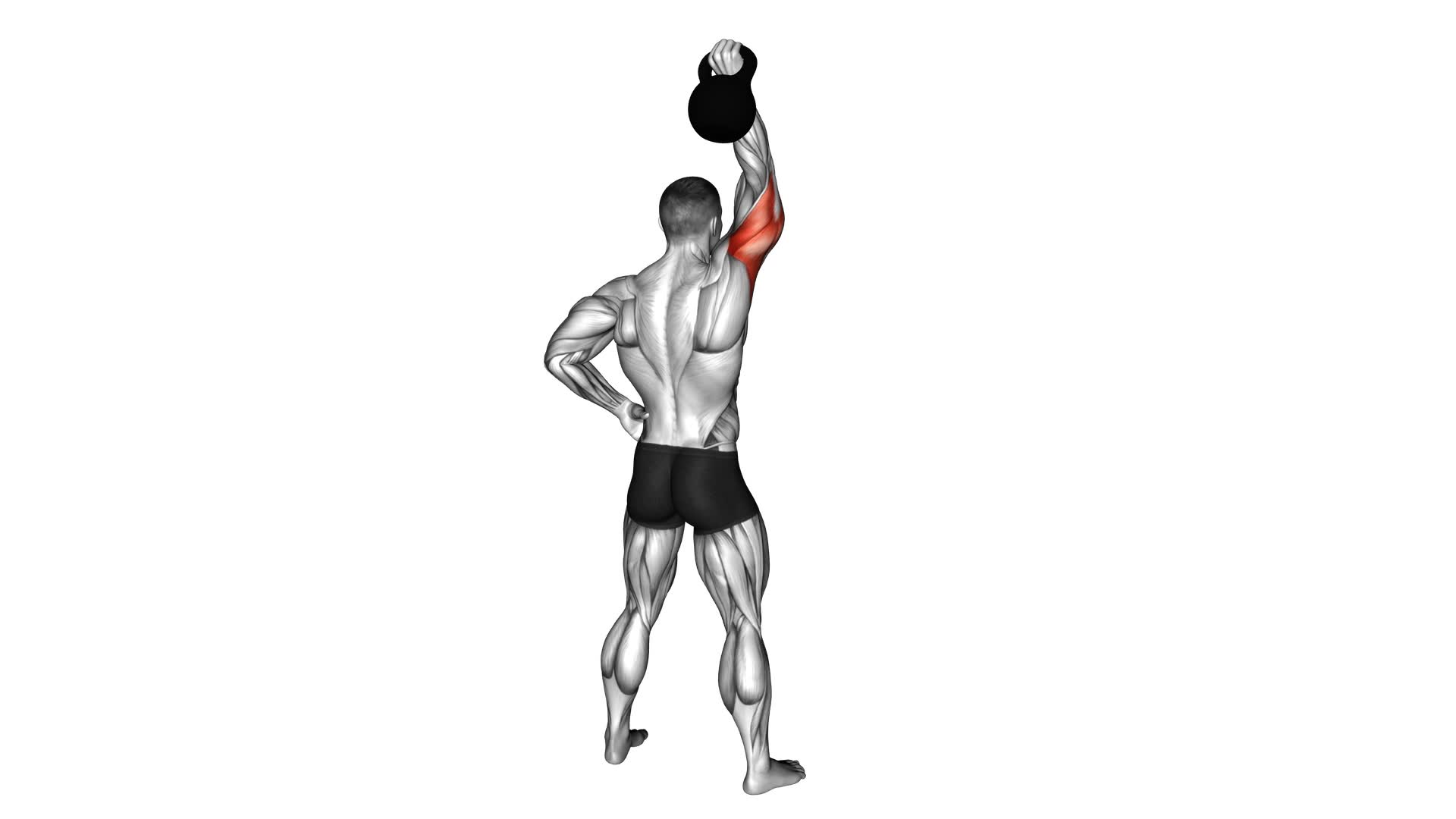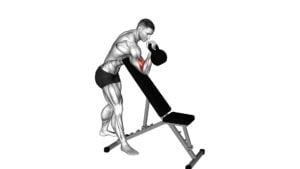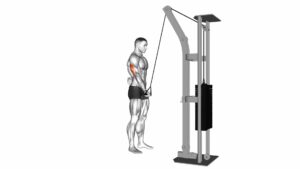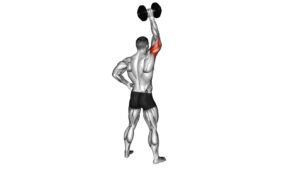Kettlebell Standing One Arm Extension – Video Exercise Guide & Tips

Looking to strengthen your arms and build upper body strength? The Kettlebell Standing One Arm Extension is the perfect exercise for you.
Watch This Exercise Video
In this video exercise guide, we'll show you the proper form and technique, as well as common mistakes to avoid.
Whether you're a beginner or advanced fitness enthusiast, we've got modifications and progressions to suit your level.
Get ready to incorporate this challenging and effective exercise into your workout routine!
Key Takeaways
- Targets multiple muscle groups, including shoulders, triceps, and core
- Builds upper body strength and improves overall stability
- Enhances balance and coordination
- Increases athleticism and performance in other activities
Benefits of the Kettlebell Standing One Arm Extension
To maximize your workout, you can benefit from incorporating the Kettlebell Standing One Arm Extension into your routine. This exercise is a great addition to your kettlebell exercises, especially if you're looking to improve your strength training.
The Kettlebell Standing One Arm Extension targets multiple muscle groups, including your shoulders, triceps, and core. By performing this exercise, you engage your upper body and build strength in these areas. This can help improve your overall strength and stability, allowing you to perform other exercises more effectively.
In addition to strength training, the Kettlebell Standing One Arm Extension also helps improve your balance and coordination. As you lift the kettlebell overhead and control the movement, you challenge your body to maintain stability and control. This can have a positive impact on your overall athleticism and performance in other activities.
Equipment and Setup for the Exercise
To properly execute the Kettlebell Standing One Arm Extension, it's crucial to select the appropriate kettlebell weight and position yourself correctly. The right kettlebell weight will challenge your muscles without causing strain or compromising form.
When setting up for the exercise, ensure that your feet are shoulder-width apart, your core is engaged, and your arm is fully extended overhead with the kettlebell in your hand.
Proper Kettlebell Weight
Choose the kettlebell weight that's appropriate for your strength and fitness level to ensure proper equipment and setup for the exercise.
When it comes to choosing a kettlebell weight, it's important to start with a weight that's manageable for beginners. For those who are new to kettlebell training, it's recommended to start with a weight between 8 to 12 kilograms (18 to 26 pounds). This weight range allows you to focus on maintaining proper form and technique without compromising your safety.
As you progress and become more comfortable with the exercise, you can gradually increase the weight of the kettlebell. Remember, it's always better to start with a lighter weight and work your way up to heavier weights as your strength and skill level improves.
Ideal Exercise Positioning
Position yourself in a stable stance with your feet shoulder-width apart and grasp the kettlebell with one hand. This exercise requires correct body alignment to ensure proper form and maximize effectiveness.
Here are some discussion ideas to consider:
- Correct body alignment:
- Keep your back straight and shoulders relaxed.
- Engage your core muscles to stabilize your spine.
- Align your head with your spine, looking straight ahead.
- Maintain a slight bend in your knees to prevent strain on your lower back.
- Importance of core engagement:
- Engaging your core muscles helps to stabilize your body and protect your spine during the exercise.
- It also increases the effectiveness of the exercise by targeting your abdominal muscles.
Proper Form and Technique for the Exercise
You should maintain a stable stance, engage your core, and fully extend your arm while performing the Kettlebell Standing One Arm Extension.
To ensure proper form and technique, it's important to be aware of common errors and modifications for beginners.
One common error is using too heavy of a kettlebell, which can lead to improper form and potential injury. As a beginner, it's recommended to start with a lighter kettlebell and gradually increase the weight as you become more comfortable and confident with the exercise.
Another common error is swinging the kettlebell instead of maintaining control throughout the movement. This can put unnecessary strain on your joints and muscles. To avoid this, focus on using a slow and controlled motion when extending your arm.
For beginners, it's also helpful to use a mirror or have a trainer provide feedback on your form. They can point out any areas where you may need to make adjustments, such as your stance or arm position.
Remember to always listen to your body and stop if you experience any pain or discomfort. By maintaining proper form and technique, you can maximize the effectiveness of the Kettlebell Standing One Arm Extension while minimizing the risk of injury.
Common Mistakes to Avoid
To maintain proper form and technique during the Kettlebell Standing One Arm Extension, it's crucial to avoid common mistakes. Here are some technique tips to help you perform the exercise correctly and prevent injury:
- Using too heavy of a weight: It's important to choose a kettlebell weight that you can comfortably control throughout the movement. Using a weight that's too heavy can lead to poor form and increased risk of injury. Start with a lighter weight and gradually increase as you build strength and confidence.
- Arching the back: One common mistake is arching the back during the extension, which puts unnecessary strain on the spine. Keep your core engaged and maintain a neutral spine throughout the exercise. This will ensure that you're targeting the intended muscles and reducing the risk of injury.
Modifications and Progressions for All Fitness Levels
Now let's talk about how you can modify and progress the kettlebell standing one arm extension exercise to suit your fitness level.
Whether you're a beginner or more advanced, there are options available for you.
Beginners can start with lighter weights or even use a dumbbell instead of a kettlebell.
On the other hand, advanced individuals can challenge themselves by increasing the weight or adding variations like a kneeling position.
It's important to adapt the exercise to your abilities to ensure safe and effective workouts.
Beginner-Friendly Modifications
One modification for beginners in the kettlebell standing one arm extension exercise is using a lighter weight. This allows beginners to focus on proper form and technique before progressing to heavier weights. Using a lighter weight also reduces the risk of injury for those who may not have built up the necessary strength yet.
To make the exercise more beginner-friendly, here are a few alternative exercises and modifications:
- Single-arm dumbbell overhead press: This exercise can be performed with a dumbbell instead of a kettlebell, allowing beginners to start with a lighter weight and gradually increase as they progress.
- Seated shoulder press: Performing the exercise while seated can provide additional stability and support for beginners who may struggle with balance or core strength.
Advanced Progression Options
As you progress in your fitness journey, there are several advanced progression options and modifications available for the kettlebell standing one arm extension exercise.
To challenge yourself further, you can increase the weight of the kettlebell or use a different grip, such as a bottoms-up grip. This will require more strength and stability in your wrist and forearm.
Another advanced modification is performing the exercise on an unstable surface, like a Bosu ball or a balance board. This will engage more muscles and improve your balance and core strength.
Additionally, you can incorporate advanced techniques, such as performing the exercise with a tempo, slowing down the movement on the eccentric (lowering) phase for added muscle control and strength development.
These advanced modifications and techniques will push your limits and take your kettlebell standing one arm extension exercise to the next level.
Now, let's explore how to adapt the exercise for different abilities.
Adapting for Different Abilities
To modify and progress the kettlebell standing one arm extension exercise for different abilities, you can make adjustments based on your fitness level and goals. Here are some ways to adapt the exercise:
- Adapting for injuries:
- If you have a shoulder injury, you can use a lighter weight or decrease the range of motion.
- For wrist or elbow pain, you can try using a different grip or switch to a different exercise that doesn't aggravate the injury.
- Modifying for different strength levels:
- If you're a beginner or have limited upper body strength, start with a lighter kettlebell or use a resistance band for assistance.
- For advanced individuals, you can increase the weight or perform the exercise on an unstable surface like a balance board.
Tips for Incorporating the Kettlebell Standing One Arm Extension Into Your Workout Routine
When incorporating the Kettlebell Standing One Arm Extension into your workout routine, begin by using a time preposition such as 'during' or 'throughout'. This exercise is a great addition to any kettlebell routine, as it targets your triceps, shoulders, and core muscles. To ensure proper form and maximize results, here are some tips to keep in mind.
First, start with a weight that challenges you but allows you to maintain proper form throughout the exercise. As you progress, you can gradually increase the weight to continue challenging your muscles.
Next, focus on maintaining a stable and strong stance throughout the movement. Keep your feet shoulder-width apart and engage your core muscles to provide stability and support.
When performing the standing one arm extension, make sure to keep your elbow close to your body and avoid swinging or using momentum to lift the kettlebell. This will help isolate and target the intended muscles effectively.
Lastly, remember to breathe throughout the exercise. Inhale as you lower the kettlebell and exhale as you extend your arm upwards. This will help you maintain control and stability.
Incorporating variations of the standing one arm extension, such as alternating arms or using a different grip, can add variety to your routine and target different muscles. Experiment with different variations to keep your workouts challenging and engaging.
Frequently Asked Questions
What Are the Potential Risks or Injuries Associated With the Kettlebell Standing One Arm Extension?
When performing the kettlebell standing one arm extension, there are potential risks and associated injuries to be aware of. It's important to maintain proper form and technique to avoid strains or sprains in your back, shoulders, or wrists.
Overexertion or using too heavy of a weight can also lead to muscle strains or tears. It's crucial to start with a lighter weight and gradually increase as your strength and technique improve to minimize the risk of injury.
How Many Repetitions and Sets Should I Do for the Kettlebell Standing One Arm Extension?
For the kettlebell standing one arm extension, the number of repetitions and sets can vary based on your fitness level and goals. It's recommended to start with 2-3 sets of 8-12 repetitions per arm. As you progress, you can increase the number of sets or repetitions. Remember to listen to your body and adjust accordingly.
Additionally, there are variations and modifications you can explore to target different muscle groups or add intensity to the exercise.
Can I Use a Dumbbell Instead of a Kettlebell for This Exercise?
Yes, you can use a dumbbell instead of a kettlebell for the standing one arm extension exercise. While kettlebells have their benefits, dumbbells can still provide a similar workout. Dumbbells offer more stability and control, making it easier to maintain proper form.
However, keep in mind that the weight distribution may feel different, so start with a lighter dumbbell and gradually increase the weight to challenge yourself. Remember to consult a professional trainer for personalized guidance.
Is It Better to Perform the Kettlebell Standing One Arm Extension With a Heavier Weight and Fewer Repetitions, or a Lighter Weight and More Repetitions?
When deciding between a heavier weight and fewer repetitions or a lighter weight and more repetitions for the kettlebell standing one arm extension, consider your goals.
Using a heavier weight will challenge your muscles more, promoting strength gains.
However, using a lighter weight with higher repetitions can help improve muscular endurance.
It ultimately depends on what you want to achieve.
Remember to always listen to your body and adjust the weight and repetitions accordingly.
Can I Do the Kettlebell Standing One Arm Extension if I Have a Shoulder or Lower Back Injury?
If you're dealing with shoulder pain or lower back pain, it's important to consult with a healthcare professional before attempting the kettlebell standing one arm extension. They can evaluate your condition and provide appropriate guidance.
It's crucial to prioritize your safety and avoid any further injury. Listen to your body and make modifications as needed. Remember, your health and well-being should always come first.
Conclusion
Incorporating the kettlebell standing one arm extension into your workout routine can offer a range of benefits, including improved upper body strength and stability.
By following proper form and technique, and avoiding common mistakes, you can maximize the effectiveness of this exercise.
Additionally, modifications and progressions are available to accommodate all fitness levels.
Add this challenging yet rewarding exercise to your routine to enhance your overall fitness and achieve your goals.

Author
Years ago, the spark of my life’s passion ignited in my mind the moment I stepped into the local gym for the first time. The inaugural bead of perspiration, the initial endeavor, the very first surge of endorphins, and a sense of pride that washed over me post-workout marked the beginning of my deep-seated interest in strength sports, fitness, and sports nutrition. This very curiosity blossomed rapidly into a profound fascination, propelling me to earn a Master’s degree in Physical Education from the Academy of Physical Education in Krakow, followed by a Sports Manager diploma from the Jagiellonian University. My journey of growth led me to gain more specialized qualifications, such as being a certified personal trainer with a focus on sports dietetics, a lifeguard, and an instructor for wellness and corrective gymnastics. Theoretical knowledge paired seamlessly with practical experience, reinforcing my belief that the transformation of individuals under my guidance was also a reflection of my personal growth. This belief holds true even today. Each day, I strive to push the boundaries and explore new realms. These realms gently elevate me to greater heights. The unique combination of passion for my field and the continuous quest for growth fuels my drive to break new ground.







